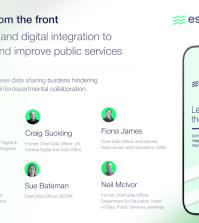Find your identity: making progress on digital ID verification

Every country wants a digital ID system – but few have successfully built them. At a recent GGF webinar, civil service leaders from Germany, Norway, and digital trailblazers Estonia and Singapore explained how they’re laying this essential foundation for online public service delivery. Adam Green reports
At the height of the COVID-19 pandemic, the Indian government used its Aadhaar digital identity system to provide subsidies to farmers, preventing food shortages. In a country where, until recently, many rural citizens had to travel long distances to access support, this was a revelation.
The scheme was a prime example of the power of digital ID systems to make government more efficient and simplify the lives of citizens, according to Pierre Lelievre, Senior Vice President for Digital ID at IDEMIA – which helps governments across the world to build identity verification systems.
In October, Lelievre took part in a Global Government Forum webinar on digital ID: alongside senior civil servants from four countries, he explored the opportunities and challenges around creating these systems – covering how to develop them, how to ensure adoption, and the thorny questions around securing citizen consent for ID cards and data-sharing.
Government savings, simplicity for citizens
At root, a digital identity system is like any other proof of ID: it gives public and private bodies confidence that the person they’re dealing with is who they claim to be. But in the digital world, this capability provides a multitude of new opportunities: given a secure log-in, citizens can – for example – access a wide range of public services within a single portal, permit government agencies to share data, and remotely perform tasks such as signing legal documents.

Any number of institutions can provide services through the platform, or establish data links to it; and the more that join, the richer the data and the greater the system’s potential applications. Involve banks, for example, and the process of paying taxes or receiving benefits can be simplified or automated. In Norway, you can now book a sunbed with your digital ID, as well as accessing government services.
Estonia and Singapore are leaders in the area, with digital ID systems stretching back decades. And at the event Ruth Annus, director general of the Citizenship and Migration Policy Department in Estonia’s Ministry of Interior, and Quek Sin Kwok, Senior Director of Singapore’s National Digital Identity Programme, outlined some of the most sophisticated applications of a digital ID.
In Estonia, Annus explained, the government uses the information stored in a digital ID to automatically offer cash benefits to qualifying citizens. The citizen avoids the time loss and stigma of applying for benefits and documenting their eligibility, while the government saves money spent on processing claims.
In Singapore, meanwhile, citizens use their digital IDs to access more than 200,000 physical spaces, such as offices and government buildings. Within a few weeks of COVID-19 arriving in the country, the government used the system to control access to different locations. The ready-made electronic log of individual movements has also proved invaluable for contact tracing, said Quek, and could form the basis for allowing more travel in and out of Singapore.
“We are nowhere near the end of COVID-19,” he added. “We are looking to gradually open up our borders by creating a health certificate system, leveraging on digital identity infrastructure.”
Different routes, same destination
Estonia and Singapore are in some ways set up for success with digital ID systems. The former built a modern bureaucracy from an almost blank slate after the collapse of the Soviet Union in the 1990s, while the latter is a city-state with a single, unified bureaucracy. Most other governments need to factor in local or regional state bodies, and different agencies with siloed record-keeping and IT systems.

But the benefits are so great that nearly all governments are now grappling with the challenge. And Stefan Schlosser, a policy advisor handling digital ID in Germany’s Federal Chancellery, pointed to the time pressures: Germany’s government has decided to act quickly, he said, before private sector players take an identity solution out of its hands completely. “We don’t have much time left because… major technology firms are making inroads into the lucrative field of digital identity, and I think that there is a danger that member states will be sidelined,” he said.
Using its existing national ID card system as a base, the German government is working with communications provider Deutsche Telekom to develop a national digital ID system and partnering with Samsung to pilot the technology on its Galaxy smartphones. The idea is for the government to define standards, which other private sector players can then develop against.
On the other hand, in Norway – said Tor Alvik, Specialist Director for Digital Strategies and Coordination in the country’s Ministry for Local Government and Modernisation – the government encouraged banks to build digital ID systems that it could then approve. More than 92% of the Norwegian population now use their bank IDs to access 2,000 services from 100 different public providers, he said.
Winning the argument
So how can government leaders ensure their digital ID systems achieve widespread adoption, winning the trust of citizens? On this issue, every member of the panel agreed: governments should not act by fiat, but by persuasion. They must demonstrate to citizens, government agencies and businesses the benefits of digital verification. Once this is clear, take up will follow voluntarily.

“Adoption is driven by trust,” said Lelievre. “If I put my data in the in the hands of an entity, either public or private, I need to understand exactly what is going to happen with this data.”
This is a principle that has underpinned Estonia’s digital ID system since its development in the 1990s. Citizens can log in to their digital ID application and see every instance in which a government employee accessed their data and what they looked at. If the citizen spots something unusual, he or she can raise an alert.
“One of the main principles of our privacy policy is that it’s a citizen who owns the data the government has about him or her,” says Annus. “That is behind the trust we have towards the government.”
When trust in a system grows, the results can be remarkable. In Estonia more than 40% of citizens used their digital IDs to cast votes in the country’s parliamentary election last year, Annus said.
In Norway, meanwhile, citizen surveys now show Norwegians want a truly national digital ID system and see it as privacy enhancing, rather than a threat, according to Alvik. This comes after the government’s integration with existing bank identity systems simplified tax collection. “The Norwegian tax agency is the sixth most liked organisation in Norway. That’s pretty strange. Nobody likes a tax agency!” Alvik joked.
Providing extra value
Consent can also be gained by making relatively simple improvements in service provision that demonstrate to citizens the value of using their digital IDs. In Singapore, for example, once parking meters shifted to a smartphone app linked to an individuals’ digital ID, citizens paid for the exact time their car remained in a parking spot, rather than having to pre-pay for 30-minute blocks.

Singapore has also been remarkably successful at encouraging private sector organisations to use the government’s ID system, rather than building their own. Again, this has resulted from effective design and the benefits that can accrue to businesses, rather than mandating behaviour.
In his presentation, Quek showed a slide of Asia’s leading fintech companies. Several of them use Singapore’s Singpass ID system to allow users to prove their identity and start making transactions at the touch of a button. That simplicity has made the services more attractive to customers; and businesses’ provision of services through the platform in turn improves the digital ID’s value to citizens, driving take-up.
As long as citizens need a different set of log-in details for every provider, argued Quek, accessing services online will always be a frustrating experience for citizens. “Digital fragmentation is the biggest threat to innovation and growth,” he said. “Digital identity bridges the fragmentation of systems to allow services and data to be more integrated. And that’s when innovation will happen.”
What comes next?

Those innovations include the use of Singapore’s system by regional start-up businesses, demonstrating the potential for digital IDs to gain relevance across borders. As citizens become increasingly mobile, creating greater need to prove their identities and access services in many states, there are growing calls for cooperation between systems. Interoperable government ID systems could allow citizens of one country to access healthcare benefits in another, for example.
In some technology circles, there is talk of growing international digital competition as countries compete to offer services to globally-mobile individuals and companies. In Estonia, for example, the government has developed an e-Residency scheme to allow foreign nationals to access government services without ever stepping foot in the country. The hope is to increase company formation in Estonia, and ultimately to gather more corporation tax receipts.
But there are also more prosaic reasons to build systems that can interact with each other. The technology that underpins digital ID systems – biometric verification, with smartphones as their current medium – sit in the hands of companies which work across borders and will inevitably push for common standards.
“Our companies say: ‘Please provide a system that doesn’t just work in Germany, because we don’t want to introduce different systems in every country’,” Stefan Schlosser explained. Germany is choosing to see this as an advantage with potential financial benefits, he added, rather than a loss of control: “The biggest reason for finding solutions that work cross-border is that the economy is very international.”
This webinar was held on 13 October, and sponsored by digital ID system provider IDEMIA. It has been amended to correct an error in our reporting of comments by Quek Sin Kwok. You can watch the 75-minute event on-demand via our event page or below and can download the slides here.





















